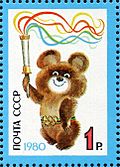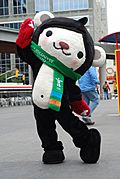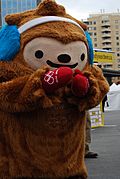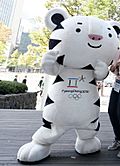Olympic mascot facts for kids
Olympic mascots are fun, fictional characters that represent the spirit of the Olympics and Paralympic Games. They are often animals or human-like figures that show off the culture of the place where the Games are held. Mascots help make the Olympics exciting for younger fans.
The Olympic Games have had mascots since the 1932 Summer Olympics in Los Angeles. The first really famous Summer Olympics mascot was Misha the bear at the 1980 Summer Olympics in Moscow. Since the 2010 Vancouver Games, the Olympic and Paralympic mascots have been shown together.
Contents
History of Olympic Mascots
The very first Olympic mascot appeared at the 1968 Winter Olympics in Grenoble, France. It was called "Schuss," a small skier designed in blue, red, and white. However, the first official Olympic mascot arrived at the 1972 Summer Olympics in Munich. This was Waldi, a Dachshund dog. Dachshunds are popular in Bavaria, Germany, and Waldi showed qualities like strength, determination, and quickness, which are important for athletes. Waldi even had three colors from the Olympic flag: blue, yellow, and green.
The success of these early mascots helped them become a big part of the Olympic Games. Mascots are very popular. Even though they carry important messages, they are designed simply with bright, happy colors to fit the exciting atmosphere of the Olympics.
Olympic Mascots Through the Years
| Games | City | Mascot | Character | Designer | What it Represented | Image |
|---|---|---|---|---|---|---|
| 1932 Summer Olympics | Los Angeles | Smoky | Scottish terrier | Born in the Olympic Village | An early, unofficial mascot. | |
| 1968 Winter Olympics | Grenoble | Schuss | Stylized skier | Aline Lafargue | An unofficial mascot, designed in the colors of France. | |
| 1968 Summer Olympics | Mexico City | Red Jaguar | An unofficial mascot. | |||
| 1972 Summer Olympics | Munich | Waldi | Dachshund dog | Otl Aicher | A popular dog breed in Bavaria, showing athlete qualities like strength and agility. | |
| 1976 Winter Olympics | Innsbruck | Schneemann | Snowman | Walter Pötsch | Represented the "Games of Simplicity." | |
| 1976 Summer Olympics | Montreal | Amik | Beaver | Yvon Laroche, Pierre-Yves Pelletier, Guy St-Arnaud and George Huel |
One of the national symbols of Canada. | |
| 1980 Winter Olympics | Lake Placid | Roni | Raccoon | Donald Moss | Its face looked like the hat and goggles athletes wear. Named after the Adirondack Mountains. | |
| 1980 Summer Olympics | Moscow | Misha | Bear cub | Victor Chizhikov | The bear was a national symbol of the Soviet Union. |  |
| 1984 Winter Olympics | Sarajevo | Vučko | Little wolf | Joze Trobec | Symbolized friendship between humans and animals. It helped change how people saw wolves. | |
| 1984 Summer Olympics | Los Angeles | Sam | Bald eagle | Robert Moore (from The Walt Disney Company) |
The national symbol of the United States. | |
| 1988 Winter Olympics | Calgary | Hidy and Howdy | Two polar bears | Sheila Scott | Both represented the friendly spirit of Western Canada. | |
| 1988 Summer Olympics | Seoul | Hodori | Tiger cub | Hyun Kim | Tigers are common in Korean legends. | |
| 1992 Winter Olympics | Albertville | Magique | Man-star/snow imp | Philippe Mairesse | ||
| 1992 Summer Olympics | Barcelona | Cobi | A Catalan sheepdog | Javier Mariscal | Designed in a modern, cubist art style. |  |
| 1994 Winter Olympics | Lillehammer | Håkon and Kristin | Two Norwegian children | They wore Viking clothes. They were the first mascots to be human figures. | ||
| 1996 Summer Olympics | Atlanta | Izzy | An abstract figure (an alien) | John Ryan | The first mascot created using computer graphics. | |
| 1998 Winter Olympics | Nagano | The Snowlets: Sukki, Nokki, Lekki and Tsukki |
Four owls | Represented the four main islands of Japan. Their names combine to sound like "Snowlets." | ||
| 2000 Summer Olympics | Sydney | Olly (from "Olympic") |
Kookaburra | Jozef Szekeres, Matthew Hatton | Represented the generous Olympic spirit. | |
| Syd (from "Sydney") |
Platypus | Represented the environment and energy of Australia. | ||||
| Millie (from "Millennium") |
Echidna | Represented the new Millennium. All three are common Australian wild animals. | ||||
| 2002 Winter Olympics | Salt Lake City | Powder (also called Swifter) |
Snowshoe hare | Steve Small, Landor Associates and Publicis |
These three mascots are native animals of Utah. They are named after important natural resources. They are also characters in local American Indian legends. | |
| Copper (also called Higher) |
Coyote | |||||
| Coal (also called Stronger) |
American black bear | |||||
| 2004 Summer Olympics | Athens | Athena and Phevos | Brother and sister | Spyros Gogos | Two modern children designed to look like ancient Greek dolls. | |
| 2006 Winter Olympics | Turin | Neve and Gliz | A human-like snowball and ice cube | Pedro Albuquerque | Neve ("Snow" in Italian) was a female snowball representing softness and friendship. Gliz ("Ice" in Italian) was a male ice cube representing enthusiasm and joy. |  |
| 2008 Summer Olympics | Beijing | The Fuwa: Beibei, Jingjing, Huanhuan, Yingying, Nini |
Koi, giant panda, Olympic Flame, Tibetan antelope, swallow | Han Meilin | Their five names together mean "Beijing welcomes you" in Chinese. Each represented an Olympic ring and a Feng Shui element. |  |
| 2010 Winter Olympics | Vancouver | Miga | Mythical sea bear | Meomi Design (Vicki Wong and Michael Murphy) |
Part orca and part kermode bear. |  |
| Quatchi | A sasquatch | From Canadian mythology. |  |
|||
| Mukmuk | A Vancouver Island marmot | Not an official mascot, but their special "sidekick". | ||||
| 2012 Summer Olympics | London | Wenlock | A drop of steel with a camera for an eye. | Iris | Named after Much Wenlock, a village that hosted early Olympic-style games. It represented the UK's Industrial Revolution. |  |
| 2014 Winter Olympics | Sochi | Bely Mishka (Polar Bear), Snow Leopard (leopard), Zaika (the dore hare) | Silvia Petrova, Vadim Pak, Oleg Serdechny | These were the first mascots chosen by a public vote. |  |
|
| 2016 Summer Olympics | Rio de Janeiro | Vinicius | A mix of all Brazilian mammals | Luciana Eguti and Paulo Muppet | Inspired by Brazilian animals. Named after the poet Vinicius de Moraes by popular vote. | |
| 2018 Winter Olympics | Pyeongchang | Soohorang | A white tiger | MASS C&G | The tiger is important in Korean stories and symbolizes trust, strength, and protection. |  |
| 2020 Summer Olympics | Tokyo | Miraitowa | A robot with blue checkered patterns | Ryo Taniguchi | A superhero-like character showing both old traditions and new ideas. Schoolchildren and artists in Japan helped choose this mascot. | |
| 2022 Winter Olympics | Beijing | Bing Dwen Dwen | A giant panda | Cao Xue | This panda wears an ice suit and loves winter sports. It shares the true spirit of the Olympics with everyone. |
Youth Olympic Mascots
| Games | City | Mascot | Character | Designer | What it Represented | Picture |
|---|---|---|---|---|---|---|
| 2010 Summer Youth Olympics | Singapore | Lyo and Merly | Red male lion (Lyo), Blue female merlion (Merly) | Cubix International | Lyo and Merly represent Singapore, known as the "Lion City," and its national symbol, the Merlion. |  |
| 2012 Winter Youth Olympics | Innsbruck | Yoggl | Alpine Chamois | Florencia Demaría and Luis Andrés Abbiati of Argentina | Yoggl showed the character of the host city, Innsbruck. |  |
| 2014 Summer Youth Olympics | Nanjing | Lele (mascot)(砳砳) | Rainflower Stone/Yuhua Stone (雨花石) | LeLe was inspired by a special "Rain-Flower Pebble" stone found in Nanjing. Its design used the stone's shape and colors. "Lele" sounds like stones hitting each other and also means happiness in Chinese. |  |
|
| 2016 Winter Youth Olympics | Lillehammer | Sjogg | Lynx | Line Ansethmoen |  |
|
| 2018 Summer Youth Olympics | Buenos Aires | Pandi | Jaguar | Human Full Agency | Pandi is a young jaguar. Its name combines the jaguar's scientific name (Panthera onca) with a nod to the "digital world." |  |
| 2020 Winter Youth Olympics | Lausanne | Yodli | A cow, Saint Bernard dog and a goat hybrid. | ERACOM | Yodli's name came from the yodeling singing style popular in Switzerland. Yodli is a mix of a cow, goat, and Saint Bernard dog, all common in the Swiss mountains. |  |
Images for kids
See also
 In Spanish: Mascota de los Juegos Olímpicos para niños
In Spanish: Mascota de los Juegos Olímpicos para niños



